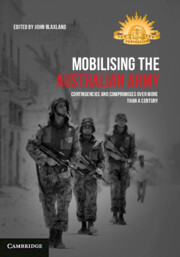Refine search
Actions for selected content:
62 results
2 - ‘That most imperfect military organization’
- from Part I - The Ascent
-
- Book:
- The Generalissimo
- Published online:
- 31 July 2025
- Print publication:
- 14 August 2025, pp 43-65
-
- Chapter
- Export citation
‘Beastial Communications’: Race, Friendship and Factionalism in the Madras Army, 1832–1837
-
- Journal:
- Transactions of the Royal Historical Society , First View
- Published online by Cambridge University Press:
- 06 August 2025, pp. 1-26
-
- Article
-
- You have access
- Open access
- HTML
- Export citation
Introduction: An Experiment in Race Relations
-
- Book:
- A Black Army
- Published online:
- 16 June 2025
- Print publication:
- 17 July 2025, pp 1-14
-
- Chapter
- Export citation
1 - The Making of Henry Lewis Stimson
-
- Book:
- Warriors in Washington
- Published online:
- 23 June 2025
- Print publication:
- 10 July 2025, pp 12-33
-
- Chapter
- Export citation
4 - Between Deterrence and Compellence
-
- Book:
- Warriors in Washington
- Published online:
- 23 June 2025
- Print publication:
- 10 July 2025, pp 98-124
-
- Chapter
- Export citation
6 - The Americans Are Coming
-
- Book:
- Warriors in Washington
- Published online:
- 23 June 2025
- Print publication:
- 10 July 2025, pp 159-179
-
- Chapter
- Export citation

A Black Army
- Segregation and the US Military at Fort Huachuca, Arizona, 1941–1945
-
- Published online:
- 16 June 2025
- Print publication:
- 17 July 2025

Mobilising the Australian Army
- Contingencies and Compromises Over More than a Century
-
- Published online:
- 23 May 2025
- Print publication:
- 30 May 2025
5 - Ancient Rome: Monarchy and Republic (753–27 bc)
-
-
- Book:
- The Cambridge History of Strategy
- Published online:
- 06 January 2025
- Print publication:
- 09 January 2025, pp 98-123
-
- Chapter
- Export citation
La surveillance : un instrument d’évitement de l'intrusion militaire dans le champ politique camerounais
-
- Journal:
- Canadian Journal of Political Science/Revue canadienne de science politique / Volume 57 / Issue 4 / December 2024
- Published online by Cambridge University Press:
- 08 January 2025, pp. 842-860
-
- Article
-
- You have access
- Open access
- HTML
- Export citation
Chapter 17 - Antioch
- from Part III - The People of Antioch
-
-
- Book:
- Antioch on the Orontes
- Published online:
- 06 June 2024
- Print publication:
- 06 June 2024, pp 272-297
-
- Chapter
- Export citation
2 - Tactical Air Power Theory
-
- Book:
- Tactical Air Power and the Vietnam War
- Published online:
- 04 January 2024
- Print publication:
- 18 January 2024, pp 13-34
-
- Chapter
- Export citation
12 - Technology, Military Reform, and Warfare in the Tokugawa-Meiji Transition
- from PART II - Economy, Environment, and Technology
-
-
- Book:
- The New Cambridge History of Japan
- Published online:
- 15 January 2024
- Print publication:
- 23 November 2023, pp 397-440
-
- Chapter
- Export citation
20 - Slaves, Indians, and the “Classes of Color”: Popular Participation in Brazilian Independence
- from Part II - Brazil, Portugal, and Africa
-
-
- Book:
- The Cambridge History of the Age of Atlantic Revolutions
- Published online:
- 20 October 2023
- Print publication:
- 09 November 2023, pp 520-546
-
- Chapter
- Export citation
THE ADLOCVTIO AT THE ACCESSION OF THE ROMAN EMPEROR
-
- Journal:
- The Classical Quarterly / Volume 73 / Issue 1 / May 2023
- Published online by Cambridge University Press:
- 15 December 2023, pp. 397-418
- Print publication:
- May 2023
-
- Article
-
- You have access
- Open access
- HTML
- Export citation
14 - Following the Footsteps of BTS
- from Part VI - Circuits of K-Pop Flow
-
-
- Book:
- The Cambridge Companion to K-Pop
- Published online:
- 02 March 2023
- Print publication:
- 09 March 2023, pp 265-280
-
- Chapter
- Export citation
10 - The BTS Phenomenon
- from Part V - The Band That Surprised the World
-
-
- Book:
- The Cambridge Companion to K-Pop
- Published online:
- 02 March 2023
- Print publication:
- 09 March 2023, pp 192-207
-
- Chapter
- Export citation
11 - Transcultural Fandom
- from Part V - The Band That Surprised the World
-
-
- Book:
- The Cambridge Companion to K-Pop
- Published online:
- 02 March 2023
- Print publication:
- 09 March 2023, pp 208-228
-
- Chapter
- Export citation

The Cambridge Companion to K-Pop
-
- Published online:
- 02 March 2023
- Print publication:
- 09 March 2023
7 - Presidential Election in 2002
-
- Book:
- Election Violence in Zimbabwe
- Published online:
- 23 February 2023
- Print publication:
- 02 March 2023, pp 159-183
-
- Chapter
- Export citation
